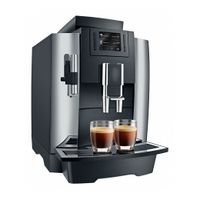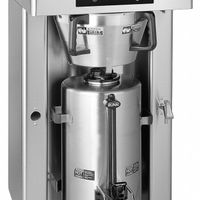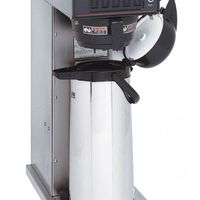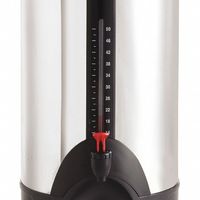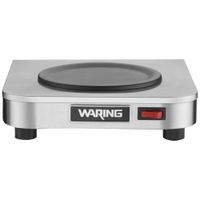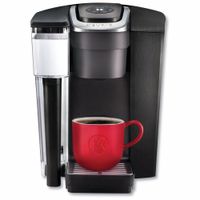Call +(254) 703 030 000 / 751 483 999 / 721 704 777
- Home
- Furnishings Appliances Hospitality
- Appliances
- Coffee Tea Brewing Equipment
- Coffee Brewers Warmers
.....Read More
Frequently Asked Questions
What is the best single-cup coffee maker?
The best single-cup coffee maker is often considered to be the Keurig K-Elite. This model stands out due to its versatility, ease of use, and consistent performance. It offers a strong brew setting for those who prefer a bolder cup of coffee and has five different cup sizes ranging from 4 to 12 ounces. The K-Elite also features an iced coffee setting, allowing users to brew hot coffee over ice without losing flavor.
One of its key advantages is the large 75-ounce water reservoir, which means fewer refills and more convenience for frequent users. The machine heats up quickly, allowing for a fast brewing process, and it is compatible with the My K-Cup Universal Reusable Coffee Filter, providing the option to use your own ground coffee.
The K-Elite's design is sleek and modern, fitting well in most kitchen settings. It also includes a programmable auto-on feature, a high-altitude setting, and a removable drip tray to accommodate travel mugs. The machine's maintenance is straightforward, with a descaling feature to ensure longevity and optimal performance.
While there are other notable single-cup coffee makers, such as the Nespresso VertuoPlus for espresso lovers or the Hamilton Beach FlexBrew for dual functionality, the Keurig K-Elite offers a comprehensive package that caters to a wide range of coffee preferences, making it a top choice for many coffee enthusiasts.
How do drip coffee makers compare to single-cup coffee makers?
Drip coffee makers and single-cup coffee makers serve different needs and preferences. Drip coffee makers are ideal for brewing multiple cups at once, making them suitable for households or offices with several coffee drinkers. They typically have a carafe that can hold 8-12 cups, allowing for easy serving and sharing. Drip machines often offer programmable features, such as timers and brew strength settings, providing convenience and customization.
Single-cup coffee makers, like Keurig or Nespresso, cater to individual servings, offering quick and easy brewing with minimal cleanup. They use pods or capsules, which provide a wide variety of flavors and types, including specialty drinks. This makes them perfect for those who prefer different coffee styles or live alone. However, the cost per cup is generally higher due to the price of pods.
In terms of taste, drip coffee makers allow for more control over the brewing process, potentially resulting in a richer flavor, especially when using freshly ground beans. Single-cup makers, while convenient, may not match the depth of flavor due to pre-packaged pods.
Drip machines are often more economical in the long run, as they use ground coffee, which is cheaper than pods. However, they require more maintenance, such as regular cleaning of the carafe and filter basket. Single-cup makers are low-maintenance but generate more waste due to disposable pods, raising environmental concerns.
In summary, drip coffee makers are best for multiple servings and cost-effectiveness, while single-cup makers excel in convenience and variety for individual use. The choice depends on personal preferences, lifestyle, and budget.
What are the advantages of a coffee brewer with a pourover water reservoir?
A coffee brewer with a pourover water reservoir offers several advantages:
1. **Control Over Brewing Process**: It allows for precise control over the water flow and temperature, which can enhance the extraction process and improve the flavor profile of the coffee.
2. **Consistency**: The manual pouring technique ensures even saturation of coffee grounds, leading to a more consistent brew compared to automatic drip machines.
3. **Customization**: Users can adjust the pouring speed and pattern, allowing for experimentation with different brewing techniques to achieve the desired taste.
4. **No Need for Plumbing**: Since it doesn't require a direct water line, it offers flexibility in placement and is ideal for spaces without plumbing access.
5. **Portability**: These brewers are generally more portable, making them suitable for travel or use in various locations.
6. **Simplicity and Reliability**: With fewer mechanical parts, pourover brewers are less prone to malfunction and are easier to clean and maintain.
7. **Enhanced Flavor**: The ability to control variables like water temperature and pour rate can lead to a richer, more nuanced coffee flavor.
8. **Aesthetic and Ritualistic Appeal**: The manual brewing process can be a satisfying ritual, and many find the aesthetic of a pourover setup appealing.
9. **Energy Efficiency**: Without the need for electricity to pump water, these brewers can be more energy-efficient.
10. **Cost-Effective**: Generally, pourover systems are less expensive than high-end automatic machines, making them accessible to a wider range of coffee enthusiasts.
How do coffee brewers with direct water line connections work?
Coffee brewers with direct water line connections are designed to be plumbed directly into a building's water supply, eliminating the need for manual refilling. These machines are typically used in commercial settings or high-demand environments due to their convenience and efficiency.
The operation begins with the water line being connected to the brewer, usually through a hose or pipe that links to the building's plumbing. A water filter is often installed in this line to ensure the water quality is optimal for brewing coffee, removing impurities that could affect taste or damage the machine.
Once connected, the brewer uses a solenoid valve to control the flow of water from the line into the machine. This valve opens and closes automatically, regulated by the machine's internal controls, to maintain the correct water level in the reservoir or boiler. The water is then heated to the appropriate brewing temperature by an internal heating element.
When a brew cycle is initiated, the machine pumps the heated water through the coffee grounds, extracting flavors and producing coffee. The direct water line ensures a continuous supply of water, allowing for multiple brewing cycles without interruption.
These brewers often feature programmable settings, allowing users to adjust brew strength, volume, and temperature. Some models also include a hot water spout for tea or other hot beverages.
Maintenance involves regular cleaning and descaling to prevent mineral buildup, as well as periodic replacement of water filters to maintain water quality. Overall, direct water line coffee brewers offer convenience, consistency, and efficiency, making them ideal for environments with high coffee demand.
What features should I look for in an automatic espresso machine?
When selecting an automatic espresso machine, consider the following features:
1. **Grinder Quality**: Look for a built-in conical burr grinder for consistent grind size and flavor extraction.
2. **Pressure Pump**: Ensure it has a 15-bar pump or higher for optimal espresso extraction.
3. **Temperature Control**: Consistent water temperature is crucial; look for machines with PID (Proportional-Integral-Derivative) controllers.
4. **Milk Frothing System**: Choose between automatic frothers or manual steam wands based on your preference for control and convenience.
5. **Programmability**: Machines with programmable settings allow you to customize shot volume, strength, and temperature.
6. **Ease of Cleaning**: Removable brew groups, automatic cleaning cycles, and dishwasher-safe parts simplify maintenance.
7. **Water Reservoir Capacity**: A larger reservoir reduces the frequency of refills, ideal for frequent use.
8. **Bean Hopper Size**: A larger hopper is convenient for storing more beans, reducing the need for frequent refills.
9. **Build Quality**: Stainless steel components are more durable and aesthetically pleasing than plastic.
10. **User Interface**: Intuitive controls, whether digital displays or touchscreens, enhance user experience.
11. **Size and Design**: Consider the machine's footprint and design to ensure it fits your kitchen space and style.
12. **Brand Reputation and Support**: Opt for reputable brands known for quality and customer service.
13. **Price and Warranty**: Balance your budget with desired features and check for a comprehensive warranty.
14. **Additional Features**: Some machines offer dual boilers, cup warmers, or adjustable spouts for added convenience.
Prioritize features based on your personal preferences, usage frequency, and budget to find the best machine for your needs.
How do coffee urns and percolators differ from other coffee makers?
Coffee urns and percolators differ from other coffee makers primarily in their design, brewing method, and capacity.
Coffee urns are large, often cylindrical containers designed to brew and dispense coffee for large groups. They use a percolation method where water is heated at the base, rises through a central tube, and percolates through coffee grounds. This cycle repeats until the desired strength is achieved. Coffee urns are ideal for events or gatherings due to their high capacity, often ranging from 30 to 100 cups.
Percolators, on the other hand, are smaller and can be used for home brewing. They also use the percolation method but are typically designed for stovetop or electric use. The process involves boiling water cycling through coffee grounds until the desired strength is reached. Percolators can produce a robust flavor but require careful monitoring to avoid over-extraction, which can lead to bitterness.
In contrast, drip coffee makers, one of the most common types, use gravity to pull hot water through coffee grounds held in a filter, producing a cleaner and more consistent brew. Single-serve pod machines, like Keurig, use pre-packaged pods for convenience and speed, offering a wide variety of flavors with minimal cleanup. Espresso machines use pressure to force hot water through finely-ground coffee, creating a concentrated shot of coffee with a rich crema.
Overall, coffee urns and percolators are distinguished by their percolation brewing method and are best suited for situations where large quantities of coffee are needed or when a strong, bold flavor is desired. Other coffee makers offer different brewing techniques and capacities, catering to various preferences and needs.
What is the best way to keep coffee warm for hours?
The best way to keep coffee warm for hours is by using a high-quality insulated thermos or travel mug. These containers are designed with double-walled stainless steel construction, which creates a vacuum seal that minimizes heat transfer, keeping the coffee hot for extended periods. Look for a thermos with a tight-fitting lid to prevent heat from escaping and to maintain the temperature effectively.
Preheating the thermos before pouring in the coffee can enhance its heat retention capabilities. To do this, fill the thermos with hot water, let it sit for a few minutes, then empty it before adding the coffee. This step ensures that the thermos is already warm, reducing the initial heat loss from the coffee.
Alternatively, an electric mug warmer can be used to keep coffee warm at a desk or stationary location. These devices use a heated plate to maintain the coffee's temperature, but they are less effective for long durations compared to a thermos.
For those who prefer a more technological solution, smart mugs with built-in temperature control are available. These mugs allow you to set and maintain a specific temperature for your coffee, often controlled via a smartphone app. However, they are typically more expensive and require charging.
Avoid reheating coffee in a microwave, as it can alter the flavor and lead to uneven heating. Instead, if you need to reheat, consider using a stovetop on low heat, stirring frequently to maintain consistency.
In summary, for the best results, use a high-quality insulated thermos, preheat it, and ensure the lid is secure. This method provides the most reliable way to keep coffee warm for hours while preserving its flavor and aroma.
